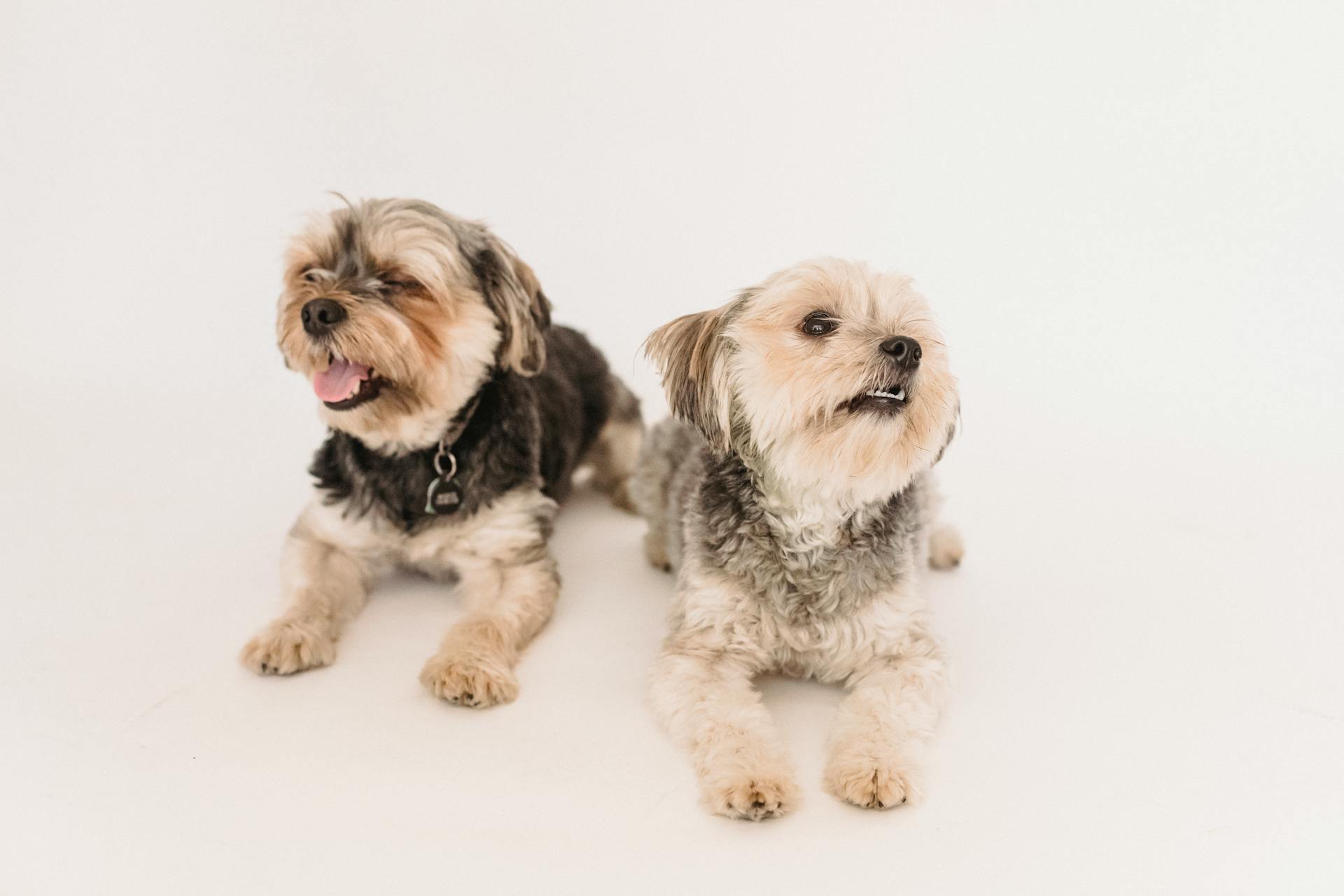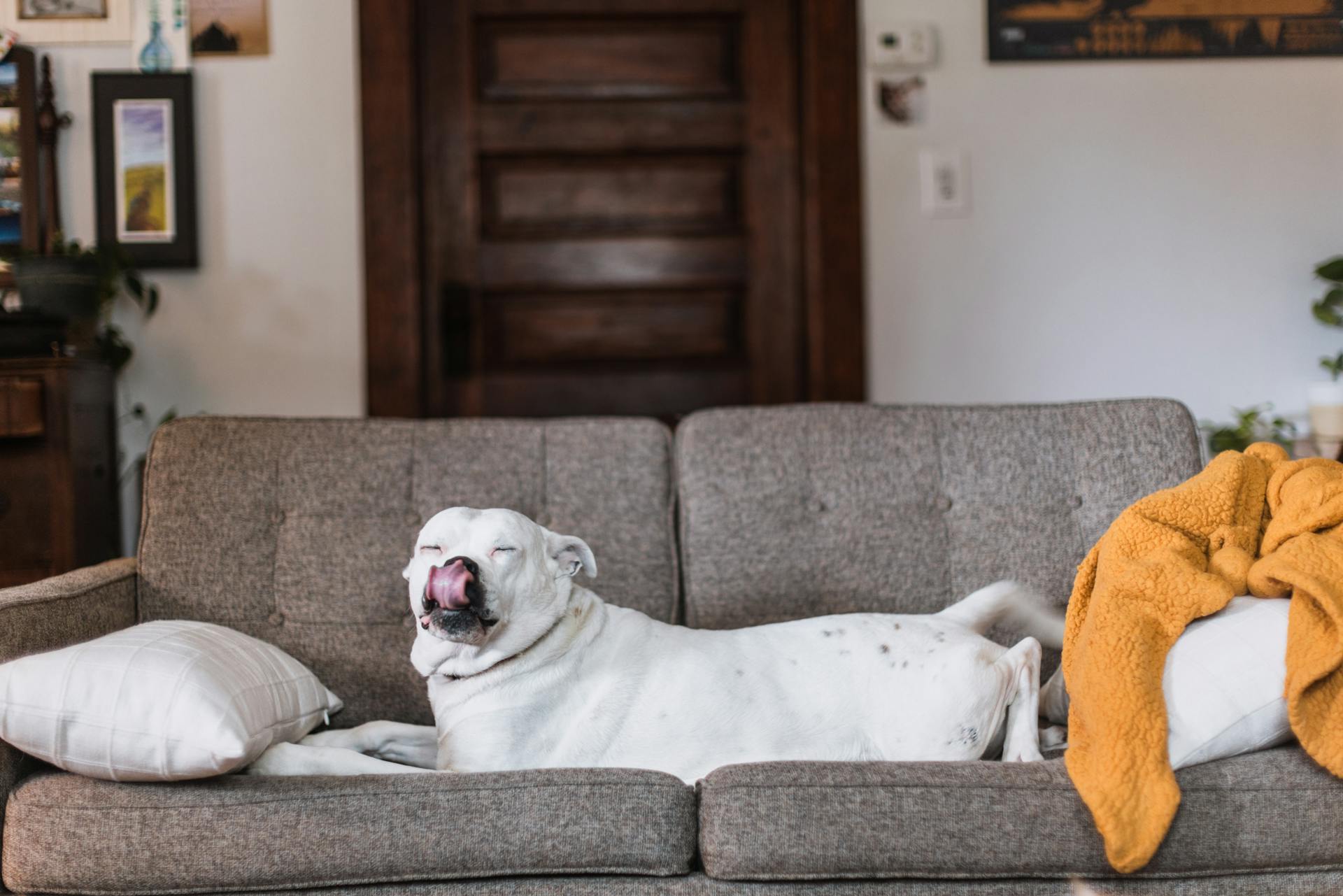
Yorkshire Terriers are prone to knee problems due to their unique anatomy and genetic predisposition.
Their knee joint is made up of a complex system of bones, ligaments, and tendons, which can be easily injured or degenerate over time.
Degenerative joint disease is a common knee problem in Yorkshire Terriers, caused by wear and tear on the joint cartilage.
This condition can lead to pain, stiffness, and reduced mobility in the knee joint.
Common Health Issues
Yorkshire Terriers are prone to knee problems, particularly patellar luxation. This condition occurs when the kneecap slips out of its groove, causing pain and discomfort.
Genetics play a significant role in patellar luxation, and it's more common in small breeds like the Yorkshire Terrier. A shallow femoral groove or malalignment of the limb can contribute to this issue.
Medial patellar luxation, which affects the inner knee, is more common in small breeds and often develops early in a dog's life. Lateral luxation, which affects the outer knee, is less frequent but more common in medium or large-breed dogs.
Here are some common signs of patellar luxation:
- A "skipping" gait, where the dog hops along for a few steps before returning to normal movement
- A clicking sound as the kneecap pops out of alignment
- A bow-legged stance
- Sitting with the knee pointing outward
- Walking stiffly or awkwardly
- Knees that don't extend fully
Common Health Issues
Luxating patella is a common health issue in dogs, and it's essential to understand the causes and signs to provide the best care for your furry friend.
Genetics play a significant role in the development of luxating patella, and it can also occur following trauma. This means that if your dog has a family history of the condition, they may be more prone to developing it.
Dogs with luxating patella tend to have a more shallow femoral groove or a general malalignment of the limb involving the femur, tibia, or hip. This can lead to the kneecap sliding or popping out of place when the knee flexes.
Small breed dogs are more commonly affected by medial patellar luxation, which often develops early in their life. In contrast, medium or large-breed dogs are more likely to experience lateral luxation, often in tandem with hip dysplasia.
As patellar luxation progresses, the patella dislocates more easily and frequently, persistently rubbing on the knee joint cartilage and leading to arthritis. This strain can also predispose dogs to other orthopedic knee conditions.
Intriguing read: Dogs like Yorkshire Terrier
Here are some common signs of luxating patella:
• Bow-legged stance
• Skipping or hopping gait
• Clicking sound as the kneecap pops out of alignment
• Sitting with the knee pointing outward
• Walking stiffly or awkwardly
• Knees not extending fully
• Kicking the leg to the side to pop the kneecap back into its groove
These signs can vary depending on the severity and location of the luxation, so it's essential to monitor your dog's behavior and consult with a veterinarian if you suspect any issues.
Clinical Signs
If your dog has patellar luxation, you might notice an intermittent "skipping" lameness when one hindlimb is lifted.
The most common sign of patellar luxation is a "skipping" gait, where your dog hops along for a few steps before resuming normal movement.
You might also hear a clicking sound as the kneecap pops out of alignment.
In some cases, dogs with patellar luxation may sit with their knee pointing outward.
As the condition progresses, you may see your dog walk stiffly or awkwardly, with knees that don't extend fully.
Some dogs learn to manage their condition by kicking their leg to the side to pop the kneecap back into its groove.
A fresh viewpoint: How to Draw Yorkshire Terrier
Caring for a Yorkshire Terrier
As a Yorkshire Terrier owner, you're probably aware that these little dogs can be prone to knee problems, specifically luxating patella. Nutrition is the foundation of good health for your furry friend, so make sure to provide a balanced diet.
Regular walking is essential to keep your dog's muscles and tendons strong, which helps support the joints. Aim for several shorter walks a day, rather than one long walk. This will help prevent inflammation, pain, and joint disease.
Here are some exercises to help strengthen your Yorkie's muscles and improve knee stability:
- Have your dog move from a sit to a stand several times in a row.
- Take your dog up and down stairs (preferably carpeted) three to five times, several times a day.
- Teach your dog to army crawl by getting into a down position and slowly luring them forward with some food.
- Walking over cavalettis encourages flexion and extension of the stifles.
- You can use leg weights above the hock and take your dog for a walk or do exercises with them on to provide resistance and improve muscle strength.
- Underwater treadmills or swimming can also strengthen the surrounding knee structures.
These exercises will help your Yorkie's quadriceps muscle become stronger, which means the patella is less likely to slip out of position.
Caring for a Terrier
Caring for a Yorkshire Terrier requires attention to their unique needs, especially when it comes to their health. To avoid common health issues, research your breeder to ensure they're certified by OFA (Orthopedic Foundation for Animals) for luxating patella.
You might like: Common Health Problems in Yorkshire Terriers
Yorkies can be prone to luxating patella, a condition where the kneecap slips out of place. Look for signs such as a bow-legged stance, skipping gait, or clicking sound as the kneecap pops out of alignment. If you notice any of these symptoms, consult your vet for a manual exam to assess the grade of luxating patella.
Proper nutrition is crucial in preventing luxating patella. Feed your Yorkie a whole food, raw meat-based diet to promote healthy connective tissue and collagen synthesis. Avoid kibble, which is high in starch and offers poor quality nutrition.
Regular walking is essential to keep your Yorkie's muscles and tendons strong, supporting their joints. Limit long walks and opt for several shorter walks a day. Managing your dog's weight is also vital, as excess weight puts pressure on joints and accelerates joint disease.
Here are some key nutrients to include in your Yorkie's diet to protect their joints and prevent luxating patella:
- Promote healthy, functional connective tissue
- Provide building blocks for collagen synthesis
- Control inflammation and pain
- Supply antioxidants
- Prevent osteoarthritis
By following these guidelines and being aware of potential health issues, you can provide the best care for your Yorkshire Terrier and ensure they live a happy and healthy life.
Research Your Breeder to Avoid Luxation
Researching your breeder is crucial when buying a puppy, especially if you're considering a breed prone to luxating patella. This condition can be inherited, and some breeds are more susceptible than others.
Yorkshire Terriers, for example, are one of the breeds that can be prone to luxating patella. In fact, research has shown that 98% of dogs with medial luxation, a common type of patellar luxation, are small breeds. And about half of all dogs with medial luxation have it in both legs.
If you're planning to buy a puppy from a breeder, you should ask whether their breeding adults are certified by OFA (Orthopedic Foundation for Animals). Dogs with congenital luxating patella shouldn't be bred.
You can also do your own research in the OFA's Records Search feature. Search for your potential puppy's parents and relatives by dog name, part of name, breed, and disease type. You can also search by kennel name.
Take a look at this: Images of Yorkshire Terrier Puppies
Here's a breakdown of the OFA clearance process:
OFA clearance doesn't guarantee your puppy won't develop the condition, but it does mean a better chance of avoiding it.
Luxation
Yorkshire Terriers are prone to a condition called patella luxation, where the kneecap (patella) slips out of its groove. This can cause pain, lameness, and arthritis in the knee.
The kneecap is supposed to sit in a groove at the end of the thighbone (femur), but in Yorkies, the groove is often too shallow, making it more likely for the kneecap to luxate.
Patella luxation can be graded on a scale of one to four, with four being the most severe. The grading dictates the type of treatment a Yorkie will get.
Symptoms of patella luxation include an unusual stride, visible pain, swelling, and muscle loss. You might also notice your Yorkie skipping or hopping along, or sitting with their knee pointing outward.
Here's an interesting read: Yorkshire Terrier Adoption Nj
In Yorkies, medial luxation is the most common type of patella luxation, where the kneecap rides on the inner part of the knee. This is often inherited and can be seen in very young dogs.
If you're planning to buy a puppy from a breeder, ask if their breeding adults are certified by OFA (Orthopedic Foundation for Animals). Dogs with congenital luxating patella shouldn't be bred.
Here are some breeds that are prone to patella luxation, including the Yorkshire Terrier:
- Miniature and Toy Poodle
- Maltese
- Bichon Frise
- Jack Russell Terrier
- Yorkshire Terrier
- Pomeranian
- Pekingese
- Chihuahua
- Cavalier King Charles Spaniel
- Papillon
- Boston Terrier
If your Yorkie has patella luxation, your vet will assess what grade it is and may take x-rays to check for any limb deformity or osteoarthritis.
Frequently Asked Questions
Can a luxating patella correct itself?
A luxating patella may return to its normal position on its own in mild cases, but this is not a guarantee and the condition may worsen over time. Spontaneous correction is possible, but it's essential to consult a veterinarian for proper evaluation and treatment.
How long can a dog live with luxating patella?
Dogs with Grade I patellar luxation can live for many years, but their condition often worsens with age, leading to arthritis and mobility issues. With proper care, some dogs can live their entire lives with this condition.
Sources
- https://manypets.com/us/blog/common-health-problems-yorkshire-terriers/
- https://www.vet.cornell.edu/departments-centers-and-institutes/riney-canine-health-center/canine-health-information/patellar-luxation
- https://www.vetwest.com.au/pet-library/luxating-patella-a-knee-cap-problem-in-dogs/
- https://www.dogsnaturallymagazine.com/treatment-options-for-the-luxating-patella/
- http://www.yorkiesunited.com/luxating-patella.html
Featured Images: pexels.com


